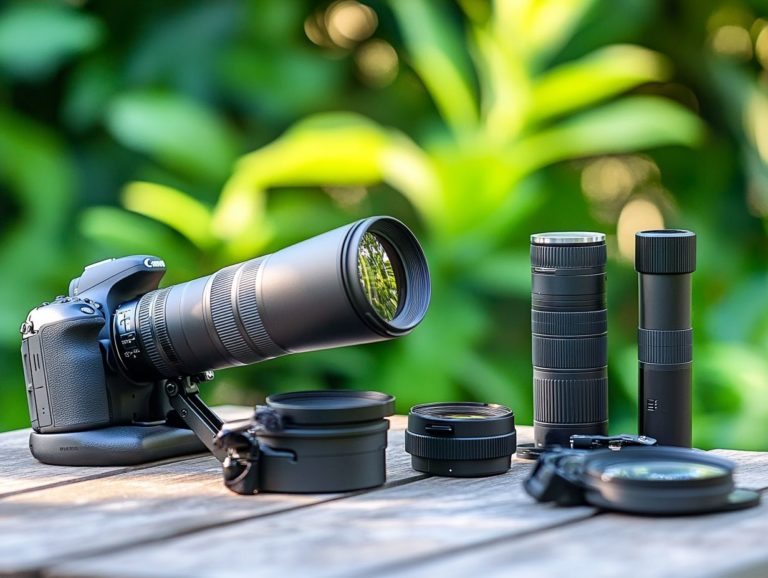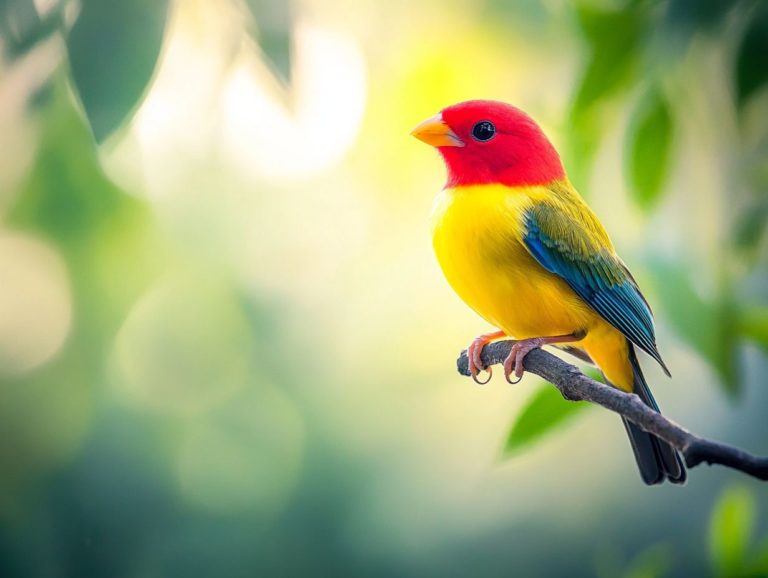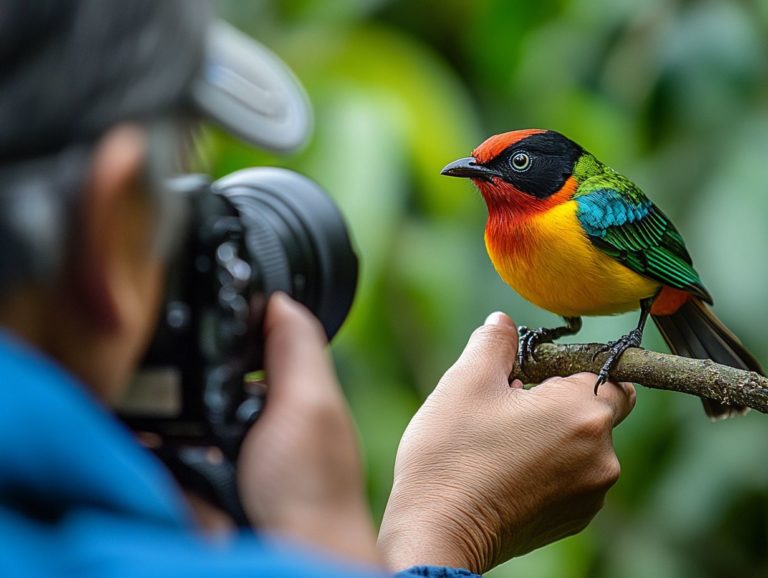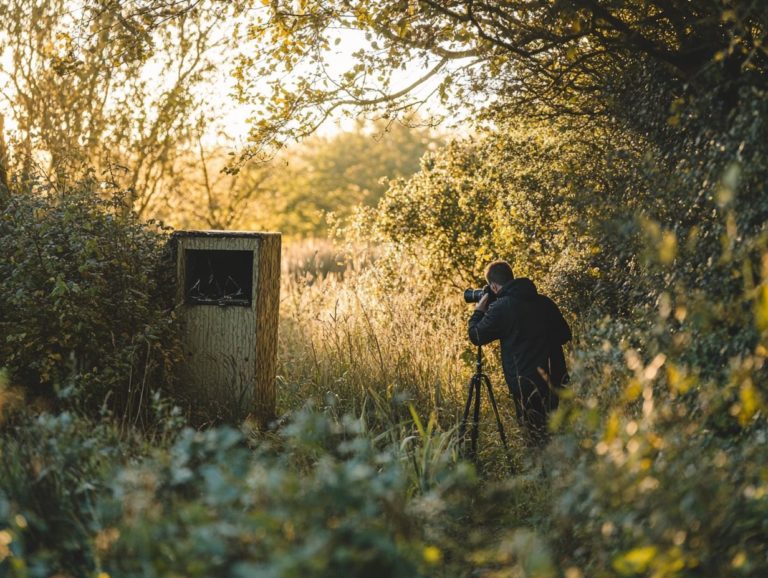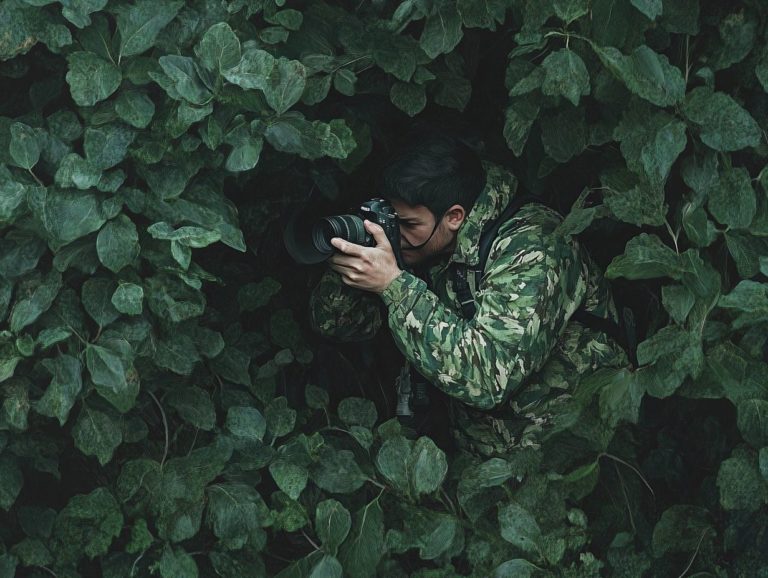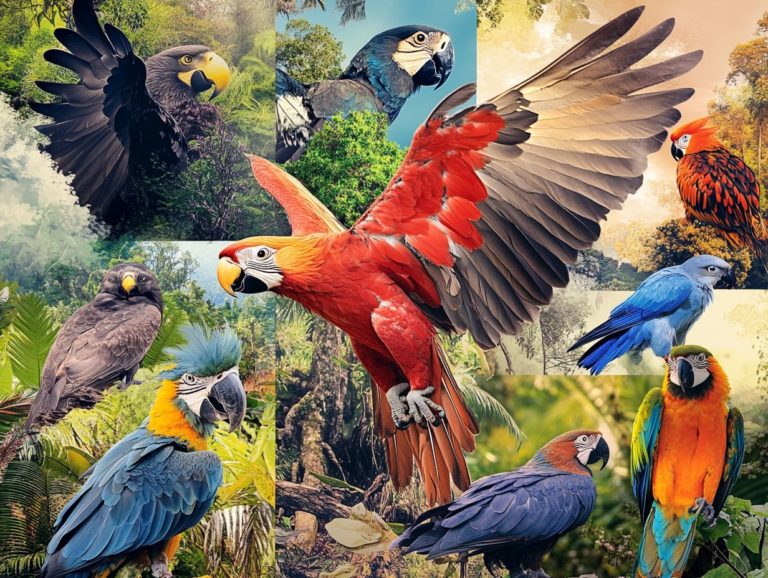The Best Photography Workshops for Birdwatchers
Bird photography combines artistry and adventure. It invites you to capture the beauty of birds in their natural habitats, making it a vital aspect of nature photography.
Whether you re a beginner or an experienced photographer, mastering bird photography requires the right equipment. You also need to understand bird behavior and effective shooting techniques.
Get ready to discover essential tips for choosing the right gear and improving your shooting techniques, navigating post-processing, and exploring top workshops that can elevate your skills.
Prepare to take your bird photography journey to new heights through hands-on learning experiences in amazing locations like Costa Rica and Ecuador! Don t miss out on the adventure!
Contents
- Key Takeaways:
- 2. Essential Gear for Bird Photography
- 3. Understanding Bird Behavior
- 4. Techniques for Capturing Birds in Flight
- 5. Composition and Framing for Bird Photography
- 6. Tips for Shooting in Different Lighting Conditions
- 7. Post-Processing for Bird Photos
- 8. How to Find and Attract Birds for Photography
- 9. Ethics and Safety in Bird Photography
- 10. Best Locations for Bird Photography Workshops with Experts
- 11. Choosing the Right Workshop for Your Skill Level
- 12. What to Expect at a Bird Photography Workshop
- 13. Testimonials from Previous Workshop Participants
- 14. Frequently Asked Questions About Bird Photography Workshops
- Frequently Asked Questions
- What are the best photography workshops for birdwatchers?
- What are the best photography workshops for birdwatchers?
- What can I expect to learn from these workshops?
- Are these workshops suitable for beginners?
- How long do these workshops typically last?
- Do I need to have a specific type of camera to participate?
- Are there any prerequisites for attending these workshops?
Key Takeaways:
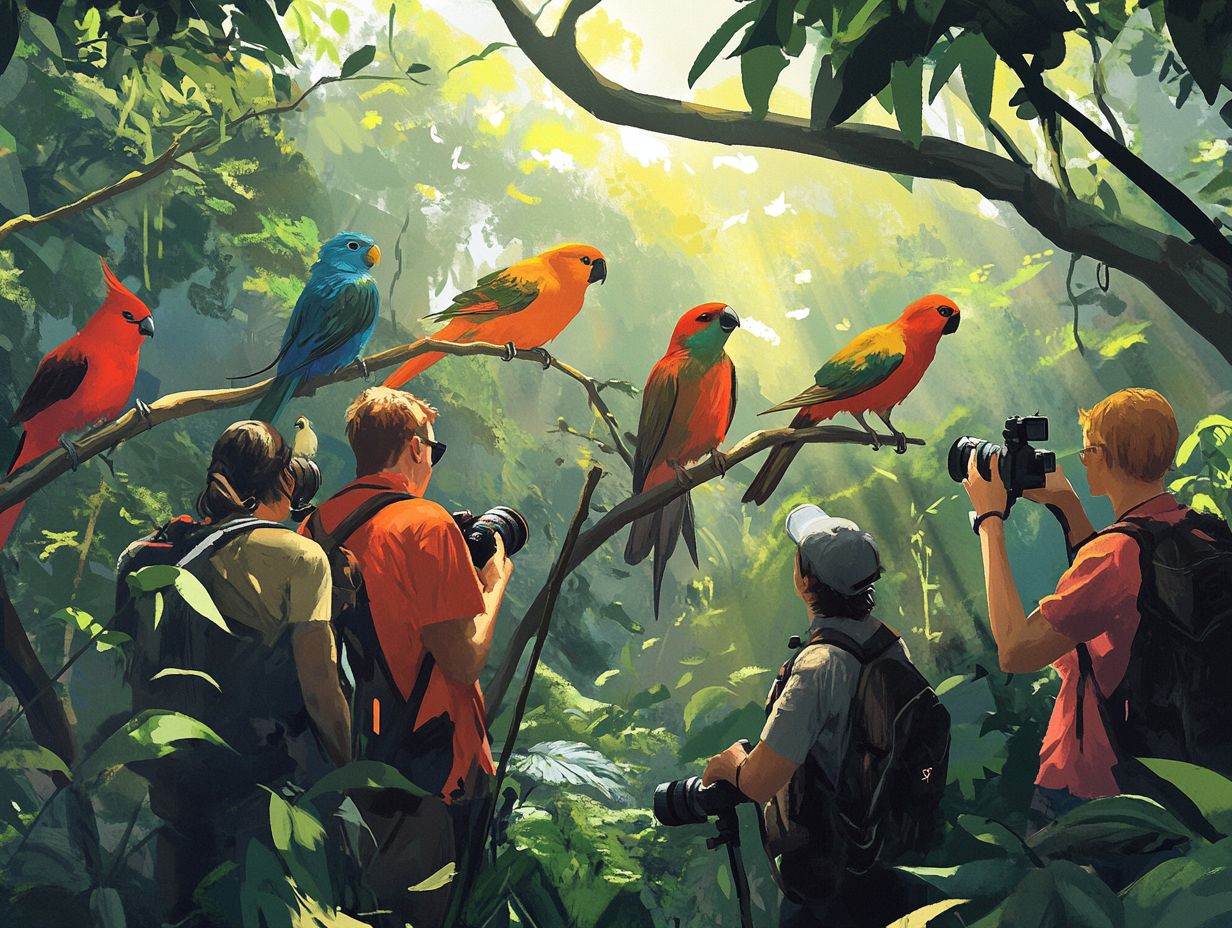
- Master the gear and techniques you’ll need to capture stunning images of birds in flight!
- Discover the best birding spots and tips for attracting birds for photography.
- Choose the right workshop for your skill level and gain valuable insights from experienced photographers.
2. Essential Gear for Bird Photography
Having the right photography equipment is essential for your success in bird photography. Brands like Canon provide high-quality gear specifically designed to help you capture stunning images of wildlife in their natural habitats, including various bird species.
If you re just starting out, a versatile Canon EOS Rebel series camera could be the perfect entry point for you. For more seasoned photographers, the Canon EOS 7D Mark II offers superior autofocus capabilities and an impressive frame rate, ideal for capturing birds in flight.
Regarding lenses, a telephoto lens with a focal length of at least 300mm is critical for zooming in on those distant birds. Don t overlook the value of accessories like sturdy tripods or monopods, which can greatly stabilize your setup and ensure sharp images, even in challenging conditions.
Whether you re working within a budget or aiming for top-tier equipment, there are options available that cater to every level of bird photography enthusiast.
3. Understanding Bird Behavior
Understanding bird behavior is crucial for your success in bird photography. It enables you to anticipate actions and capture breathtaking images of various species in their natural habitats.
By paying attention to how different species interact with their surroundings like the playful dives of a kingfisher or the intricate courtship displays of a peacock you can better predict their movements and identify moments of peak activity. For example, knowing that herons often stand still for prolonged periods while hunting can present the perfect opportunity to capture their elegance in action.
Using fieldcraft techniques, such as remaining quiet and blending into your surroundings, can significantly boost your chances of photographing elusive birds like the American bittern or the quicksilver hummingbird, which are often featured in workshops with experts.
Familiarizing yourself with birdwatching techniques, including tracking calls and understanding feeding habits, will not only elevate the quality of your photographs but also enrich your overall experience in the field.
4. Techniques for Capturing Birds in Flight
Capturing birds in flight requires a unique set of techniques that prioritize timing, optimal lighting, and precise camera settings. These elements showcase the elegance and beauty of these magnificent creatures, making it a crucial aspect of wildlife photography.
First, ensure your focus settings are designed for fast-moving subjects. Using a setting that helps keep moving birds in focus can dramatically enhance your ability to capture these energetic beings clearly. For shutter speed, aim for at least 1/1000th of a second to effectively freeze the action.
Composition is also important. Consider using the rule of thirds to create a more engaging photograph. This technique can make your photos truly stand out!
Lighting plays a vital role in image quality. Shooting during the golden hour infuses your photos with warmth and depth, while natural backlighting produces a stunning halo effect around the bird.
Post-processing can greatly enhance your photos. Adjusting contrast, sharpening details, and enhancing colors can transform a good shot into a breathtaking masterpiece.
5. Composition and Framing for Bird Photography
Mastering composition and framing is essential for bird photography. These elements profoundly influence how viewers perceive your images.
Understanding principles like the rule of thirds can elevate a simple photograph into a stunning work of art. Positioning the bird off-center creates a more dynamic and engaging composition.
Using leading lines such as branches or winding water paths naturally guides the viewer’s eye to the subject, enhancing focus and intrigue. Employing framing techniques adds depth and context to your images.
Ultimately, your creative vision is inspired by the beauty of nature. This vision weaves these techniques together, resulting in outdoor photographs that resonate with your audience.
6. Tips for Shooting in Different Lighting Conditions
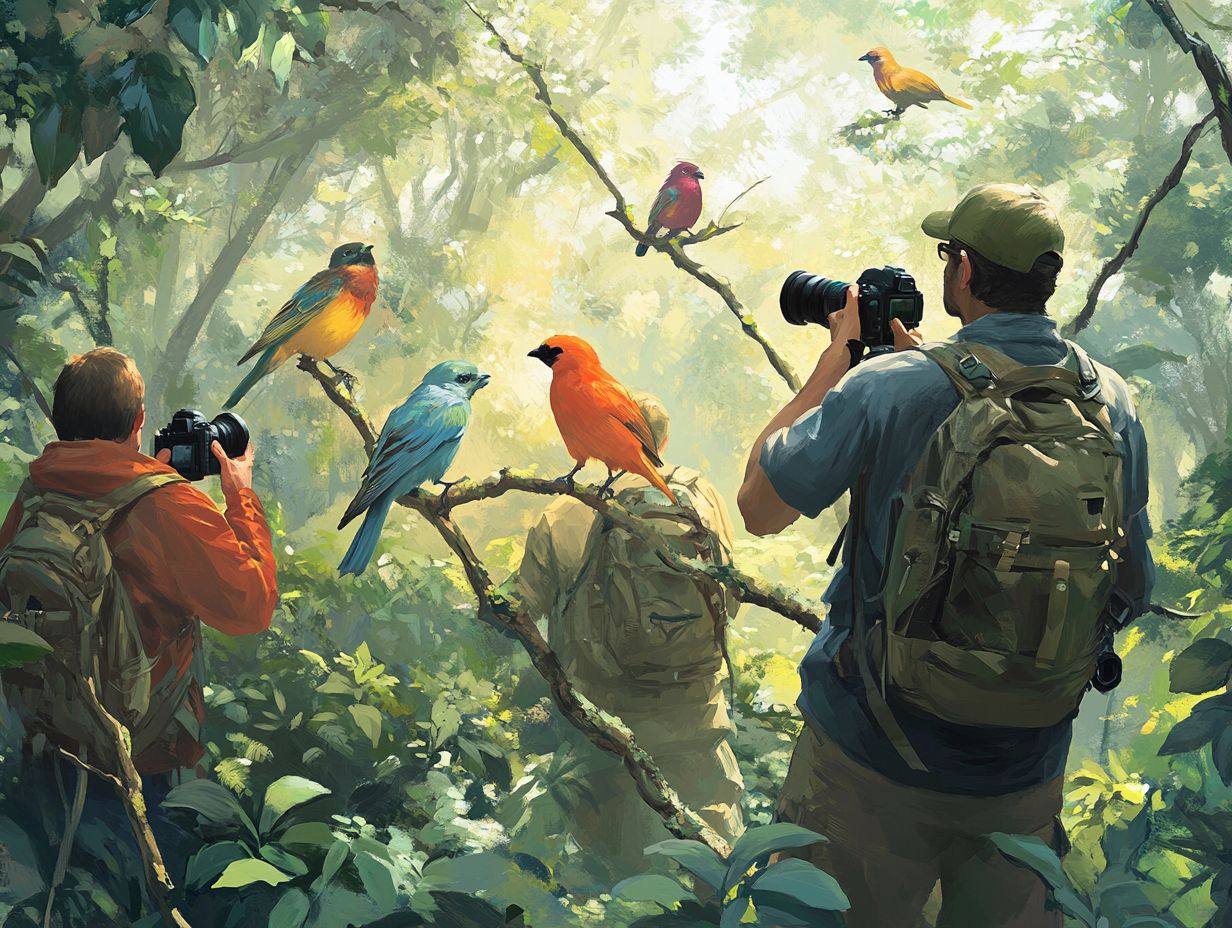
Shooting in various lighting conditions presents unique challenges for bird photographers. You must adapt your techniques to ensure high-quality wildlife images.
Whether chasing the enchanting hues of the golden hour or facing harsh midday sunlight, each scenario demands a strategic approach. During golden hour, the soft, warm light enhances colors and adds depth, making it the perfect time for vibrant shots.
In contrast, the relentless midday sun can create unflattering shadows and overexposed highlights. You ll need to increase your shutter speed or use a polarizing filter to tackle harsh rays.
On overcast days, diffused light softens textures, offering a unique opportunity to capture fine details without harsh contrasts. Incorporating post-processing techniques like adjusting exposure and contrast can significantly elevate your images.
Ensure that the final results are not only striking but also true to life. Get out there and start capturing the beauty around you today!
7. Post-Processing for Bird Photos
Post-processing is an essential aspect of bird photography. It enables you to enhance images and rectify shortcomings from the shooting phase using software like Photoshop and Lightroom.
These powerful tools offer vital techniques. For example, cropping refines your framing, influencing the viewer’s focus and engagement with the subject. Color correction is also crucial, bringing out the vivid hues of plumage and backgrounds.
Noise reduction is key, especially for images captured at higher ISOs, where grain can compromise clarity. By mastering these techniques, you can create breathtaking wildlife images that reflect the essence of birds in their natural habitats.
8. How to Find and Attract Birds for Photography
To photograph birds, you need to understand where they live and how they act. This helps you find the best places to see birds for capturing breathtaking wildlife images.
To maximize your chances of spotting various bird species, start by researching popular birdwatching locations that often attract participants during field sessions. These include wetlands, forests, and coastal areas renowned for their high avian activity. Keeping track of the times when birds move to different areas can also reveal thrilling opportunities for observation, as many birds adhere to specific routes during their journeys.
You can enhance your photography by attracting birds to your garden. By using bird feeders filled with seeds and maintaining native plants, you not only entice local species to visit but also create a vibrant and lively environment, perfect for conservation efforts and community engagement. This setting is ideal for capturing exquisite photographs that show the beauty of avian life.
9. Ethics and Safety in Bird Photography
Ethical practices and safety should be paramount in your bird photography journey. Not only do they ensure the welfare of wildlife, but they also promote conservation efforts, allowing you to fully enjoy this rewarding hobby while participating in the birding community.
As a photographer, you must remain vigilant about your impact on the environment, especially when approaching nesting sites, which are crucial for the survival of many bird species. It s essential to maintain a respectful distance to avoid disturbing the parents and chicks during sensitive breeding seasons, ensuring the safety and welfare of the birds. By being aware of local regulations and guidelines, you can prevent unintentional stress to wildlife.
When you prioritize these ethical considerations, you re not just protecting the subjects of your passion; you also become an advocate for bird conservation. Documenting and sharing your experiences can raise awareness about the challenges birds face, inspiring others to join the effort in safeguarding these precious creatures and their habitats, aligning with the ethical practices in wildlife photography.
10. Best Locations for Bird Photography Workshops with Experts
Selecting the ideal locations for your bird photography workshops can significantly elevate your learning experience. Destinations like Costa Rica and Ecuador not only offer rich biodiversity but also feature expert-led activities that cultivate a sense of community among participants.
These amazing locations offer more than just birdwatching; they provide immersive experiences that blend breathtaking natural scenery with hands-on instruction. In Canada, you can find vibrant workshops set in regions like the Pacific Northwest or the expansive boreal forests. Here, seasoned instructors will guide you through the intricacies of capturing stunning avian subjects under various lighting conditions.
In Ecuador, the Amazon Basin serves as a spectacular backdrop, teeming with colorful species while offering invaluable tips on leveraging natural habitats for dynamic shots. Meanwhile, Costa Rica s lush rainforests and tranquil coastal areas present unique opportunities to refine your techniques. You’ll leave with stunning images and new skills that make you a better photographer.
Grab your camera and head out to explore the beauty of birdwatching today!
11. Choosing the Right Workshop for Your Skill Level
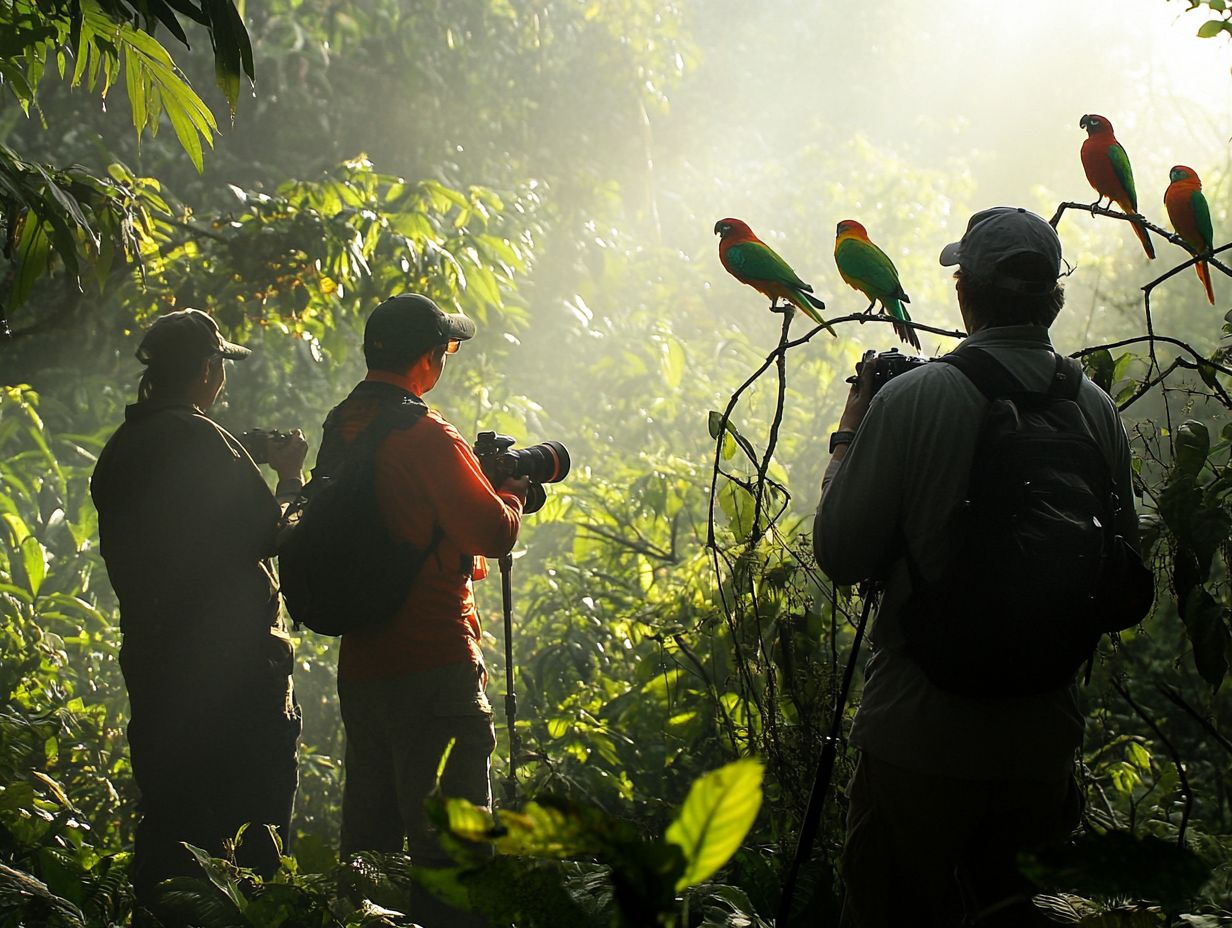
Choosing the right bird photography workshop tailored to your skill level is crucial for maximizing your learning experience and honing your technical skills in wildlife photography. Attending these workshops for beginners can provide a solid grounding and help you develop a strong foundation in nature photography.
Understanding the differences between beginner and advanced offerings gives you the power to invest your time and resources wisely. As a beginner, you ll find immense value in workshops that cover the essentials, including camera functions, composition, and basic fieldcraft (the skills used in outdoor photography). These elements provide a solid foundation for your growth.
For those with more experience, seeking out workshops that explore specific techniques, such as advanced lighting or wildlife behavior, will present the challenges needed to elevate your craft. Engaging in hands-on learning opportunities, like field sessions with real-time feedback from seasoned instructors, is essential for refining your skills and capturing breathtaking images in the wild.
12. What to Expect at a Bird Photography Workshop
Join a bird photography workshop for an exciting chance to learn from the experts! You will engage in immersive, hands-on experiences and elevate your skills through practical field sessions that cover photography equipment and techniques for birds, enhancing your understanding of birding.
During these workshops, you can anticipate a well-structured program that seamlessly blends classroom instruction with outdoor excursions. This setup allows you to immediately apply the new techniques you acquire. You ll receive personalized feedback on your work, along with valuable insights on equipment choices and settings tailored for various lighting conditions.
The advantages extend beyond just improving your technical skills; the networking opportunities within the birding community are truly priceless. Interacting with fellow enthusiasts cultivates a supportive environment where you can exchange experiences and tips. This enriches your learning journey while forging lasting connections that may lead to exciting future collaborations and conservation efforts.
Don t miss out on the chance to elevate your photography skills today!
13. Testimonials from Previous Workshop Participants
Testimonials from previous workshop participants offer invaluable insights into the life-changing experiences available through bird photography workshops. These stories showcase the incredible impact of expert instruction and community engagement, including mentorship from figures like David Suzuki, all while enhancing your understanding of nature photography.
Countless individuals have shared how these workshops not only sharpened their technical skills but also ignited their passion for wildlife and birdwatching. Many express a newfound confidence in their photography abilities, often leading to a deeper appreciation for nature itself.
Participants often highlight the joy of connecting with like-minded enthusiasts, forging lasting friendships rooted in a shared love for birding. This solidifies the sense of community that is so vital to the experience.
The warmth and support within this community encourage you to explore your creativity. With guidance from seasoned instructors, even novices leave feeling empowered and inspired to continue their photographic journey. Many go on to explore online courses or courses on photography to further enhance their skills.
Join our thriving community today and experience this transformation for yourself!
14. Frequently Asked Questions About Bird Photography Workshops
Frequently asked questions about bird photography workshops serve as a valuable resource, helping you understand what to expect, how to prepare, and the benefits of immersing yourself in these enriching experiences in birding spots around the world.
By exploring these inquiries, you ll glean insights into various aspects, including the average costs of enrolling in these workshops, which can vary depending on location and duration, such as workshops in Canada. You might also want to ask about the essential equipment you should bring along think cameras, lenses, and specialized gear for birdwatching.
It s crucial to evaluate whether your current skill level aligns with the workshop s expectations, as many sessions cater to a spectrum of expertise, from beginners to seasoned photographers. Ultimately, you can discover the tangible learning outcomes that await you, such as enhanced techniques including techniques to capture stunning shots and a deeper appreciation for your avian subjects.
Frequently Asked Questions
What are the best photography workshops for birdwatchers?
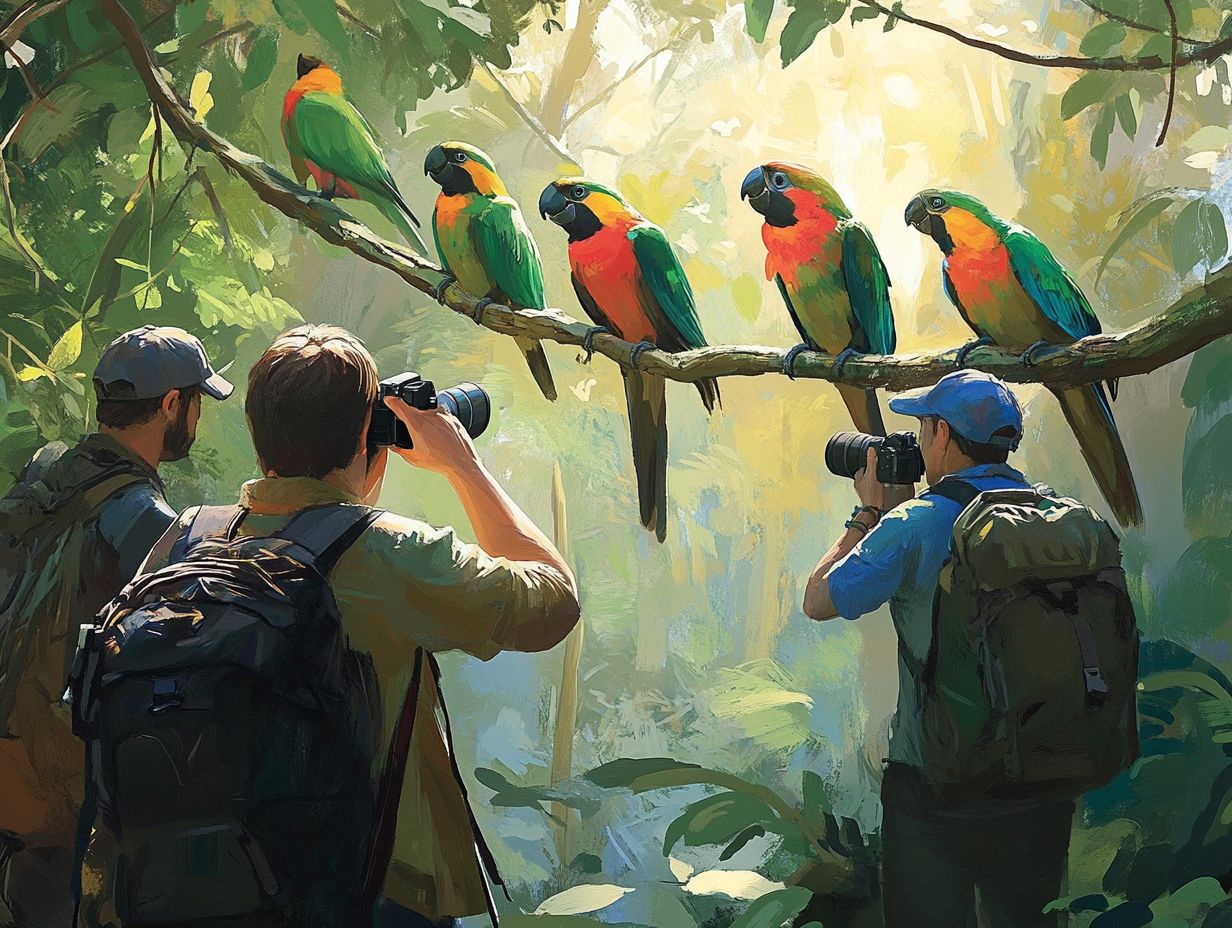
Some of the best photography workshops for birdwatchers include Audubon Nature Institute’s Bird Photography Workshop, National Audubon Society’s Advanced Bird Photography Workshop, and Cornell Lab of Ornithology’s Digital Photography for Birders Workshop. Additionally, don’t miss the top bird photography exhibitions to visit, which focus on fieldcraft and the skills needed to observe and photograph wildlife effectively, along with understanding wildlife behavior to enhance your skills.
What are the best photography workshops for birdwatchers?
Some of the best photography workshops for birdwatchers include Audubon Nature Institute’s Bird Photography Workshop, National Audubon Society’s Advanced Bird Photography Workshop, and Cornell Lab of Ornithology’s Digital Photography for Birders Workshop.
What can I expect to learn from these workshops?
These workshops are packed with essential skills to elevate your bird photography! They cover critical topics such as camera settings, composition, field techniques, and post-processing specifically for bird photography, including editing techniques using popular software like Lightroom and Photoshop. Additionally, you can explore top bird photography resources online to enhance your learning. You will also gain hands-on experience in the field with experienced instructors who will guide you through techniques for capturing stunning imagery.
Are these workshops suitable for beginners?
Yes, many of these workshops cater to all levels of photographers, including beginners. They provide a basic understanding of photography before diving into more specific techniques for bird photography, ensuring a comprehensive learning experience that can ignite your passion for wildlife.
How long do these workshops typically last?
The duration of these workshops can vary, but they usually range from 1-3 days. Some workshops may also offer extended options for more in-depth learning and exploring birding spots around the globe.
Do I need to have a specific type of camera to participate?
No, these workshops are open to photographers with all types of cameras, including DSLRs, mirrorless, and point-and-shoot cameras. However, it is recommended to have a camera with manual settings, which allow you to control exposure and focus, for the best learning experience, particularly for capturing fast-moving subjects like hummingbirds and other bird species.
Are there any prerequisites for attending these workshops?
Some workshops may require basic knowledge of photography, while others are open to all levels. It is best to check the specific workshop’s requirements before registering, particularly for those focused on advanced techniques and specific areas like wildlife photography.

